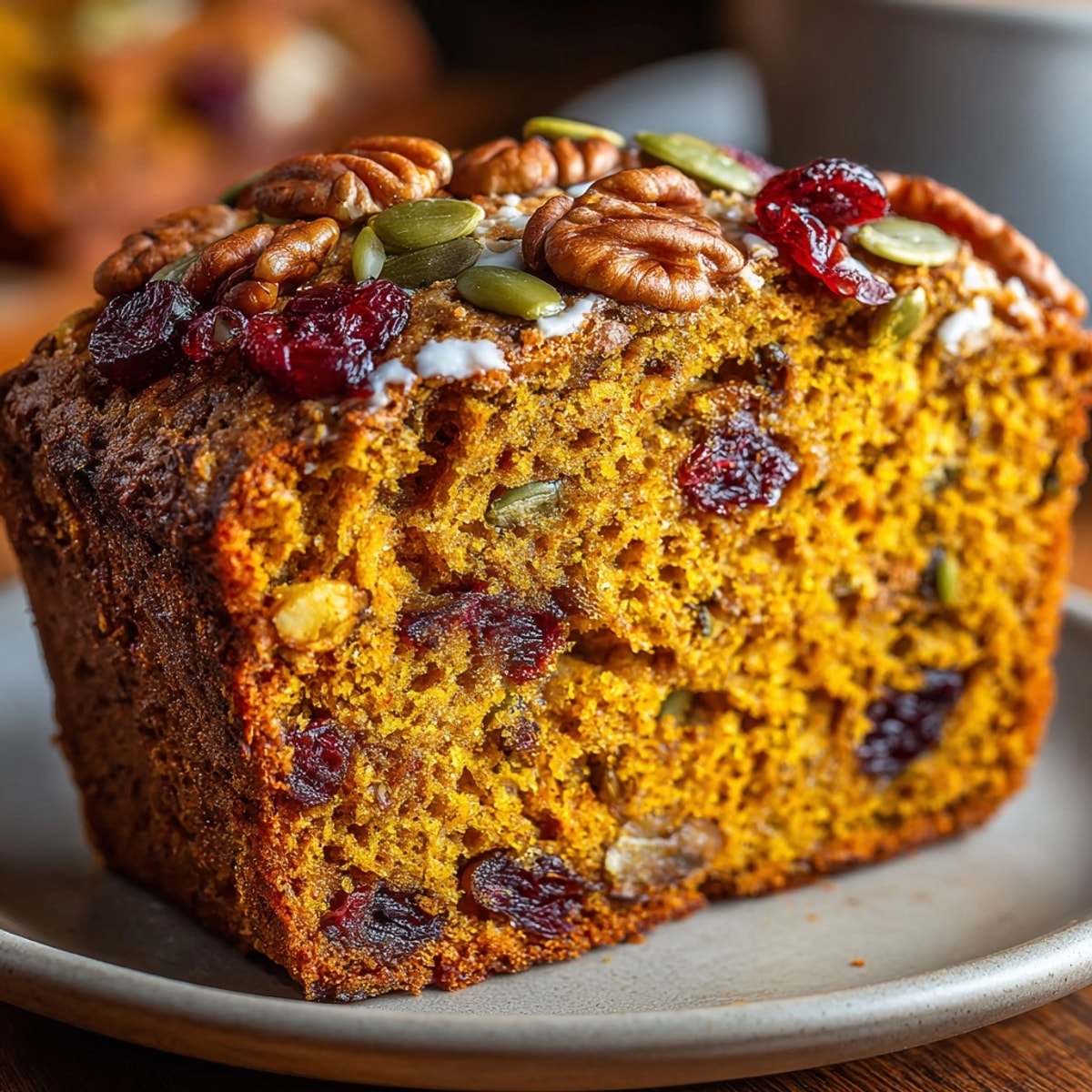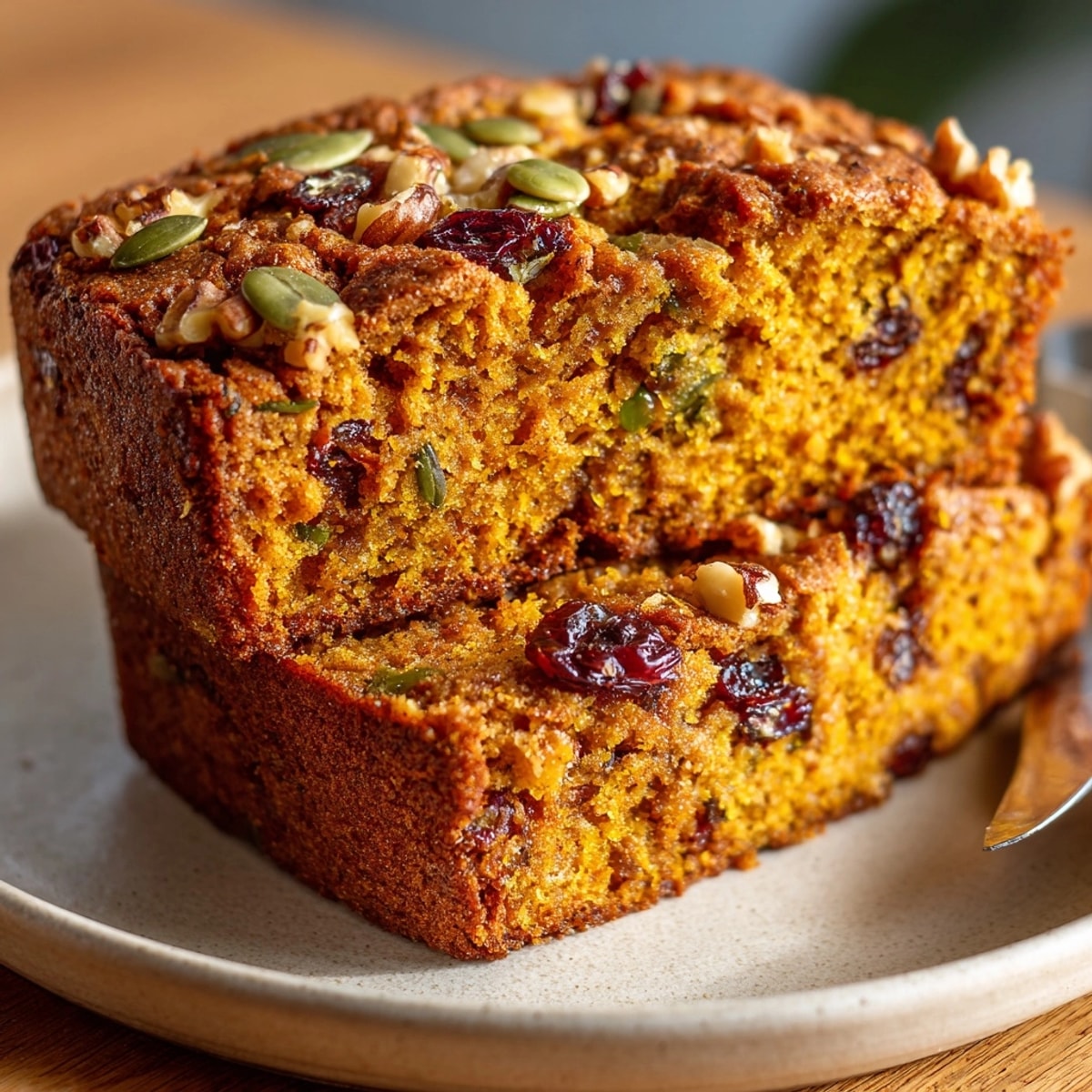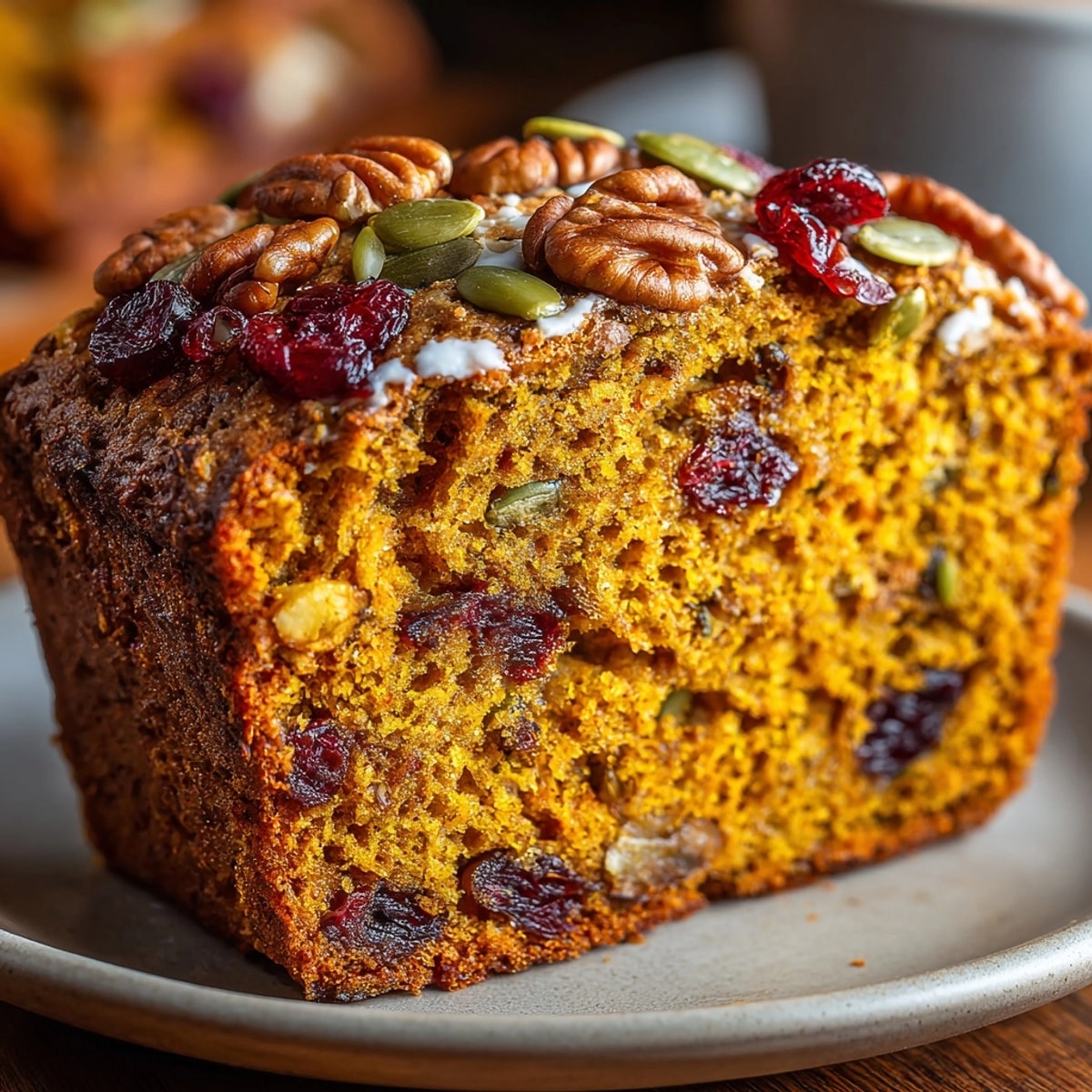 Pin
Pin This no-knead pumpkin spice bread has become my ultimate fall obsession, a rustic loaf that's moist, fragrant, and loaded with pumpkin puree and warm spices, all without the hassle of kneading. It's the kind of easy bake that fills your kitchen with cozy aromas and delivers slices perfect for slathering with butter on chilly mornings.
I whipped this up one crisp October weekend when I had leftover puree from pie-making, and it turned into a family favorite, my husband sneaking slices for snacks and the kids asking for it on weekends.
Ingredients
- all-purpose flour: 3 cups, the backbone for a sturdy yet soft crumb, choose unbleached for better rise and flavor.
- fine sea salt: 1 1/2 teaspoons, essential for balancing the sweetness and enhancing the spices, always use fine for even distribution.
- pumpkin pie spice: 2 teaspoons, the heart of the autumn vibe with notes of nutmeg and clove, freshly ground if you can for maximum punch.
- ground cinnamon: 1/4 teaspoon, optional for that extra cozy layer, pick Ceylon variety for milder warmth if available.
- instant yeast: 2 teaspoons, quick-acting to handle the heavy pumpkin without extra effort, store in the fridge for longevity.
- granulated sugar: 1/4 cup, adds subtle sweetness to feed the yeast, organic cane sugar works great for a cleaner taste.
- pumpkin puree: 1 cup, provides moisture and earthy depth, use pure canned or homemade without added sugars for best texture.
- lukewarm water: 1 cup around 100 degrees Fahrenheit, activates the yeast gently, filtered if your tap is chlorinated.
- neutral oil like canola: 2 tablespoons, keeps the crumb soft without heaviness, avocado oil is a nice upgrade for subtle nuttiness.
- vanilla extract: 1 teaspoon, rounds out the spices with a hint of warmth, real extract over imitation for authentic flavor.
- chopped pecans or walnuts: 1/2 cup, optional, brings crunch and richness, toast them lightly first to avoid sogginess.
- dried cranberries or raisins: 1/2 cup, optional, adds chewy bursts of sweetness, plump them in warm water if they're too dry.
Instructions
- Mix the Dry Ingredients:
- Start in a large mixing bowl by whisking together the 3 cups of all-purpose flour, 1 1/2 teaspoons fine sea salt, 2 teaspoons pumpkin pie spice, 1/4 teaspoon ground cinnamon if using, 2 teaspoons instant yeast, and 1/4 cup granulated sugar. Take your time here, about a minute of thorough whisking with a fork or whisk, to ensure everything is evenly distributed and no lumps of yeast or spice clumps hide in the flour, which could lead to uneven rising later.
- Prepare the Wet Ingredients:
- In a separate medium bowl, combine the 1 cup pumpkin puree, 1 cup lukewarm water, 2 tablespoons neutral oil, and 1 teaspoon vanilla extract. Stir gently with a spoon until the puree loosens up and blends smoothly with the liquids, about 30 seconds, creating a thick, orange mixture that will bring all the moisture and flavor to the dough without overworking it.
- Combine Wet and Dry:
- Pour the wet mixture into the dry ingredients all at once. Using a wooden spoon or sturdy spatula, stir everything together with slow, deliberate motions, scraping the sides and bottom of the bowl to incorporate all the flour. Stop as soon as a sticky, shaggy dough forms, no more than 20-30 stirs, because overmixing can toughen the texture, and remember, this batter-like consistency is what makes no-knead magic happen.
- Incorporate Add-Ins if Desired:
- If adding nuts or fruit, gently fold in the 1/2 cup chopped pecans or walnuts and 1/2 cup dried cranberries or raisins with just a few folds of your spatula. Be careful not to overdo it, as the dough is delicate at this stage, and you want the add-ins suspended evenly without deflating the early yeast bubbles starting to form.
- First Rise:
- Cover the bowl loosely with plastic wrap or a clean damp kitchen towel to trap warmth without sealing too tightly. Place it in a warm, draft-free spot like your kitchen counter away from cold windows, and let it rise undisturbed for 2 full hours. You'll see it double in size, becoming bubbly and poufy, which means the yeast is feasting on the sugars and building that airy structure.
- Prepare the Pan:
- While the dough rises toward the end, line a 9x5-inch loaf pan with parchment paper, letting it overhang the sides for easy removal, or lightly grease it with a neutral oil and a sprinkle of flour. This prevents sticking, especially important with the sticky dough, and parchment makes cleanup a breeze.
- Transfer and Shape the Dough:
- Once risen, use a greased spatula or your lightly oiled hands to scrape the dough directly into the prepared pan, letting it plop in without much fuss. With the back of your spatula dipped in a bit of water to prevent sticking, gently smooth the top surface, pushing it into the corners evenly. Dont worry if its uneven, the second rise will help it settle into a nice loaf shape.
- Second Rise with Oven Prep:
- Leave the pan uncovered on the counter and preheat your oven to 375 degrees Fahrenheit right away, which gives the dough 30-45 minutes to puff up again while the oven heats. Aim for it to rise until the top is domed and jiggly, about an inch above the pan rim, signaling its ready for baking without collapsing later.
- Bake to Perfection:
- Slide the pan into the middle rack of the preheated oven and bake for 40-45 minutes straight through. Check doneness by inserting a toothpick into the center, it should come out clean or with a few moist crumbs, and the top will be a deep golden brown with a hollow sound if you tap it. If it browns too quickly, tent loosely with foil after 30 minutes to avoid over-caramelizing.
- Cool Completely:
- Let the loaf cool in the pan on a wire rack for exactly 10 minutes to set the structure without steaming. Then, lift it out using the parchment handles or invert gently onto the rack, and cool fully for at least 1-2 hours before slicing. This step is crucial as cutting too soon releases steam and makes the crumb gummy instead of delightfully soft.
 Pin
Pin To keep your loaf fresh, wrap it tightly in plastic wrap or store in an airtight container at room temperature for up to three days. For longer, slice and freeze individual pieces in zip-top bags, thawing as needed, they toast up like new. I always slice the whole thing right after cooling and freeze most, since it disappears too fast otherwise.
Ingredient Substitutions
If pumpkin puree is out of season, swap in an equal amount of mashed sweet potato or butternut squash for similar moisture and color. For a nut-free version, skip the pecans and double up on the dried fruit, or try pumpkin seeds on top for crunch. I learned the hard way once with expired yeast, so always test yours in a bit of warm water first if in doubt.
Serving Suggestions
Toast thick slices and spread with softened cream cheese swirled with a touch of maple syrup for breakfast luxury. It pairs perfectly with a steaming mug of chai or spiced coffee, or even as a base for French toast on lazy weekends. We love it alongside soups too, like butternut, for a full autumn meal.
Cultural Historical Context
No-knead breads trace back to simple peasant methods in Europe, where long rises developed flavor without fancy tools, and pumpkin spice draws from American harvest traditions since the 1800s. This version twists it into a modern comfort food, blending convenience with seasonal nostalgia.
Seasonal Adaptations
In summer, lighten it with zucchini puree instead of pumpkin and swap spices for lemon zest. For winter, add orange zest to the batter for citrus brightness against the cold. Spring calls for fresh berries folded in place of dried fruit.
Helpful Notes About the Recipe
Watch the water temperature closely, too hot kills the yeast, too cold slows everything down. If your kitchen is chilly, place the rising dough near a warm oven pilot light for better results. Experiment with whole wheat flour subbing half the all-purpose for more nutty depth, but add a splash more water.
 Pin
Pin A friend of mine, always intimidated by baking, nailed this on her first try and now hosts weekly bread-sharing brunches, crediting the no-knead ease for her confidence boost.
Recipe FAQ
- → What makes this bread moist and flavorful?
The combination of pumpkin puree and lukewarm water creates a sticky dough that traps moisture during rising and baking, while pumpkin pie spice and optional cinnamon add warm, aromatic depth.
- → Can I substitute ingredients for different flavors?
Yes, swap pumpkin puree for butternut squash or sweet potato for a twist. Add chopped nuts or dried fruit during mixing to introduce crunch and subtle sweetness without altering the base structure.
- → How do I know when the bread is fully baked?
Look for a golden brown top and insert a toothpick into the center—it should emerge clean. If the loaf sounds hollow when tapped on the bottom, it's ready after 40-45 minutes at 375°F.
- → Is this bread suitable for dietary restrictions?
It's naturally vegetarian, dairy-free, and egg-free. Note it contains gluten from all-purpose flour; for nut-free, skip pecans or walnuts. Always check spice labels for cross-contamination.
- → How should I store the baked loaf?
Cool completely on a wire rack, then wrap tightly in plastic or store in an airtight container at room temperature for up to three days. For longer, freeze slices individually for easy toasting.
- → What pairs well with this spiced bread?
Toast slices and spread with cream cheese or honey for breakfast. It complements chai tea or spiced coffee, enhancing the autumn flavors in every bite.